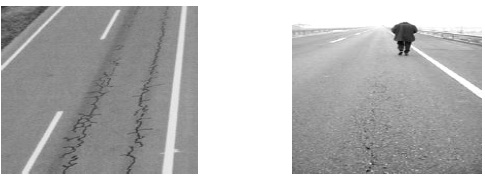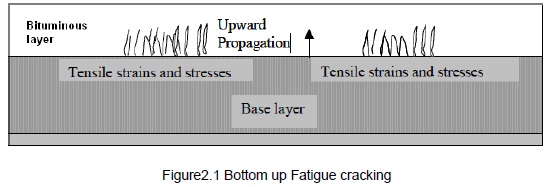





Published on Nov 30, 2023
Top down cracks (TDC) in pavements initiate at the pavement surface and propagate downward. Top down cracking appears to be a common mode of Flexible pavement distress in at least several states and countries. Traditionally, pavement cracking is thought to initiate at the bottom of the pavement layer where the tensile bending stresses are the greatest and then progress up to the surface (a bottom-up crack).
Most traditional transfer functions used in mechanistic-empirical structural design are based on this concept . However, the late 1990s saw a substantial focus on a second mode of crack initiation and propagation, top-down cracking. Although not fully understood at this time, there are three basic views on the of topdown cracking mechanism · High surface horizontal tensile stresses due to truck tyres (wide-based tyres and high inflation pressures are cited as causing the highest tensile stresses).
Age hardening of the bitumen binder resulting in high thermal stresses in the bituminous surface (most likely a cause of the observed transverse cracks). A low stiffness upper layer caused by high surface temperatures. Likely, the mechanism is some combination of the above. The pavement top-down cracking is not thoroughly understood and, at this time, is generally not considered as a causative factor for pavement cracking although it probably should be.
Further, for two states that recently studied cracking origins (Florida and Washington State), both reported that top-down cracking is far more common than assumed. In fact, the Florida DOT reports that top-down cracking is dominant for their flexible pavements due for rehabilitation. Currently, the National Cooperative Highway Research Program (NCHRP) is addressing the issue with Identification of the Design Conditions and Critical Factors That Are Related to the Top Down Cracking of flexible pavements.

Two simple suggestions may help in the identification of top-down cracking. First, in thick bituminous pavements, consider top-down cracking as a possible cracking mechanism. Generally, previous research has found that in pavements thicker than about 160 mm (6.3 inches) top-down cracks can be and often are the dominant form of cracking. We cannot assume pavement cracks are bottom-up. Second, before deciding on a maintenance or rehabilitation strategy, take a pavement core on a suspect crack. Usually, a pavement core will show whether a crack is top-down or bottom-up. It will also show the extent to which the crack has propagated, thus defining the extent of needed milling prior to overlay.
Top down cracking has become an bitumen surface course distress of growing concern that must also be dealt with during the design, construction, maintenance, and resurfacing of long-life bitumen pavements. The surface course is designed for heavy vehicle loadings and general traffic conditions in terms of rutting resistance, durability, noise levels, smoothness, and frictional characteristics. The surface course must be properly maintained and should be renewable on an 18 to 22 year cycle. A pavement management and maintenance system is very important to achieving this objective.
It is very important that top- up cracking, which is a rather complex surface distress mode related to tensile and shear stresses associated with non-uniform tyre stresses, interlayer slippage, thermal stresses, stiffness gradients, construction problems such as segregation, and premature bitumen binder age hardening, is mitigated in order to achieve satisfactory overall pavement performance. Pavement maintenance is the key to pavement preservation. Which includes all the methods and techniques used to retire and reinstate or maintain a specified level of service as well as to prolong pavement life by slowing its detorietion rate. Generally neglecting or delaying the road maintenance activities may increase the overall cost of repair as well as increase in vehicle operating costs for road users. For a proper perspective of maintenance problems, it is useful to review the link of activities leading from the design stage through the construction stage before maintenance takes over.
Right from the very beginning, the structural design of flexible pavement is facing with uncertainties such as traffic prediction and assumptions of pavement layer strength in the design. During construction, quality of road will also depend on work site and supervisory staff. Inclement weather also affects quality control by increasing chances of pavement layer contamination, which requires special attention by the supervisors. Finally after the road construction, both environmental and traffic stress will contribute to possible of the road to deteriorate. The rates of deterioration will much depend on the severity of traffic loads and variability of the road materials as well as environment effects.
To ensure the smooth operation, the road pavement has to be constantly maintained and upgraded.
The aim of this study is to assess the overall flexible pavement maintenance activities. The study is carried out for following objective:
1. To Study the properties and characteristics that most strongly influence surface cracking performance.
2. To study pavement maintenance activities and rehabilitation works carried out in the flexible pavement.
3. To study the design specification for bitumen mixtures that would mitigate surface cracking in pavements.
This type of fatigue cracking first shows as short longitudinal cracks in the wheel path that quickly spread and become interconnected to form a chicken wire/alligator cracking pattern. These cracks initiate at the bottom of the bituminous layer and propagate to the surface under repeated load applications.
This type of fatigue cracking is a result of repeated bending of bituminous layer under traffic. Basically, the pavement and bituminous layer deflects under wheel loads that results in tensile strains and stresses at the bottom of the layers. With continued bending, the tensile stresses and strains cause cracks to initiate at the bottom of the layer and then propagate to the surface .This mechanism is illustrated in figure below
The following briefly lists some of the reason for the higher tensile strains and stresses to occur at the bottom of the bituminous layer
· Relatively thin and weak bituminous layers for the magnitude and repetitions of the wheel load.
· Higher wheel loads and higher tyre pressures
· Soft spots or areas in unbound aggregates base materials or in the subgrade soil.
· Weak aggregate base/Sub base layers caused by inadequate compaction or increases in moisture contents and or extremely high ground water table.

Top-down cracking in bitumen pavements initiates from the top and propagate downwards through the bitumen concrete layer over time. Svasidisant, Schorsch and Baladi have defined three categorizers for the top-down cracking. In the first stage single short longitudinal cracks appear just outside the wheel path in the pavement surface. Over time the cracking reaches a second stage where the short longitudinal cracks grow longer and sister cracks develop parallel to and within 0.3 to 1.0 meters from the original cracks. At the third stage the parallel longitudinal cracks are connected via short transverse cracks. Also, Myers, Roque and Ruth (1997) reported the location of surface cracks being just outside the wheel path and the cracks penetrate to depths ranging from just under pavement surface to the entire depth of bitumen layer.
The Federal Highway Administration (FHWA) Accelerated Loading Facility (ALF) study (Stuart, Mogawer & Romero, 2000) for bottom-up fatigue cracking showed that the transverse bottom-up cracking started in the wheel path area. Longitudinal top-down cracks occurred at the outer edges of the wheel paths where the surface of the pavement has a high curvature. Also fatigue cracks were smaller at 28°C than at 19 and 10°C, indicating how crack propagation changes with temperature. The time interval for the cracks to appear seems to be very versatile ranging from one year to five years. The study by Svasidisant et al. (2002) shows that surface cracks had propagated through all bitumen layers in a 15 year old pavement with rubblized base. In pavements with the same base structure but only 9 to 10 years old, surface cracks had propagated 100% through the surface layers but only about 50% and 20% through the intermediate and base layers, respectively.
The two major potential solutions for top down cracking focus on the most controllable factors
1. Improved heavy vehicle loadings control (weigh-in motion scales for instance - difficult but imperative for developing countries) and appropriate mechanical, axle and tyre technology implementation (suspension systems and tyres properly matched, inflated and kept in good operating condition - very difficult, but again imperative for developing countries);
2. Improved renewable, specialized bitumen surface courses (open graded friction course, stone mastic bitumen and Superpave, for instance) with good permanent deformation (rutting) resistance, and enhanced tensile and shear stress endurance.
1. The surface cracks in the wheelpath areas were largely attributed to radial shear forces under truck tyres near the tyre edges.
2. Both thermal and load related effects can cause the surface cracking.
3. Longitudinal or transverse types of cracks were initially caused by thermal stresses and then further propagated by traffic loads.
4. A rapid hardening of the bitumen binder likely contributed to propagate pavement Cracks.
5. Cracks can form at any time of period depending on construction and type of materials used in construction.
6. Modify current pavement design practices.
7. TDC is a major distress in segregated areas. So quality of construction should be improved.
8. Pavement maintenance should be given more importance.
| Are you interested in this topic.Then mail to us immediately to get the full report.
email :- contactv2@gmail.com |